Infographic: 10 Things You Should Know About Water
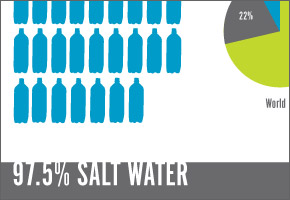
How much drinkable water is there in the world? How much water does an American, a European, an African use everyday? How many people lack even basic access to clean water? Circle of Blue’s newest infographic aims to answer these questions and many more.
With 6,000 children dying every day (water fact #7) from preventable water related diseases, readily accessible and easily understood information is vital to solving the world water crisis. Circle of Blue strives to identify and describe the dimensions of the global freshwater crisis in ways not imagined only a few years ago. Print these graphics and post them in your classrooms, offices, homes, or whereever you think people should know more about water.
10 Things You Should Know:
1 – One drop of oil can make up to 25 liters (6.6 gallons) of water undrinkable.
2 – Seventy percent of the world’s water is used for agriculture, 22 percent for industry and 8 percent for domestic use. Low and middle income countries use 82 percent of their water for agriculture, 10 percent for industry and 8 percent for domestic use. High income countries use 30 percent of their water for agriculture, 59 percent for industry and 11 percent for domestic use.
3 – A person is able to survive one month without food but only five to seven days without water.
4 – Of all the Earth’s water, 97.5 percent is salt and 2.5 is fresh. Of that water, about 70 percent is locked in glacial ice and 30 percent in soil, leaving under 1 percent (.007 percent of the total water) readily accessible for human use.
5 – A water footprint, or virtual water, is the amount of water used in the entire production and/or growth of a specific product. For example, 1 kilogram (2.2 lbs) of beef has a water footprint of 16,000 liters (4,226.8 gallons); one sheet of paper has a water footprint of 10 liters (2.6 gallons); one cup of tea has a water footprint of 35 liters (9.2 gallons); and one microchip has a water footprint of 32 liters (8.5 gallons).
6 – It takes 94.5 to 189.3 liters of water (25 to 50 gallons) to take a five-minute shower; 7.6 to 26.5 liters (2-7 gallons) to flush a toilet; 7.6 liters (2 gallons) to brush one’s teeth; and 75.7 liters (20 gallons) to hand wash dishes.
7 – 6,000 children die each day from preventable water-related diseases.
8 – The population of the United States is approximately 304 million; the population of Europe is approximately 732.7 million; 1.1 billion people lack adequate drinking water access; and 2.6 billion people lack basic water sanitation.
9 – The average American uses about 575 liters of water (151.9 gallons) per day, with about 60 percent of that being used out-of-doors (watering lawns, washing cars, etc.). The average European uses 250 liters of water (66 gallons) per day. 1.1 billion people lack adequate water access, using less than 19 liters (5 gallons) per day.
10 – The average American uses 30.3 times more water than a person who lacks adequate water access; the average European uses 13.2 times more water than a person who lacks adequate water access.
Circle of Blue’s east coast correspondent based in New York. He specializes on water conflict and the water-food-energy nexus. He previously worked as a political risk analyst covering equatorial Africa’s energy sector, and sustainable development in sub-Saharan Africa. Contact: Cody.Pope@circleofblue.org

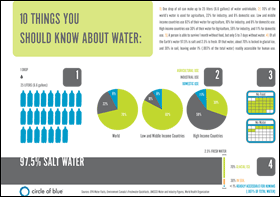
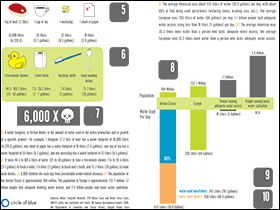

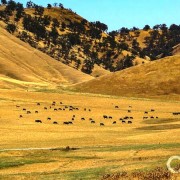
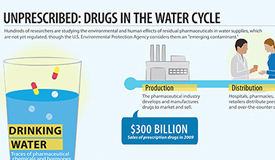
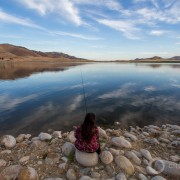
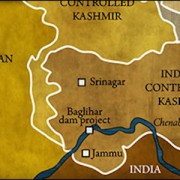


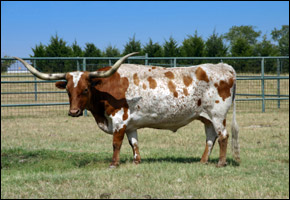

We can not make more water……just think of all the water we could save!
What if I told you water was worth more than money…..how much would you save?
off we go to saving water i really like this information by the way did you hear the speech that comes from 2070 if you did not hear i want to advise you. it is also very true WE CAN SAVE OUR LIFE I LOVE WORLD I LOVE WATER I LOVE PEOPlE Hope you`ve got same idea with me
It’s all relative.. Obviously wasting of water is bad, requiresa lot of energy to clean then clean sewage again, however relativity cames with availability. Desert dweller will use 10-20 liters a day or less on another hand Canadian will use hundrets times of that. Wherever water is avail. you can afford “overuse” , if not used it will go back to the oceans anyway.. The issue is not water..or water use habits.. the issue is overpopulation in th areas where only small amounts of water are avail. Controlling population growth in the areas of low water avail. is ythe onlyanswer to this
Just checking, is your 10 things on the Commons? Would like to share it on my Scribd acct. for other people to see. Please LMK. Thank you.
HEY JAKE. HOW CAN YOU EVEN SAY ANYTHING LIKE THAT? YOU WOULDN’T WANT ANYONE TELLING YOU WHEN YOU CAN,OR WHEN YOU CAN’T HAVE A BABY!! THE ISSUE ISN’T CONTROLLING POPULATION IN LOW WATER AREAS,IT’S BRING MORE WATER TO HIGHER POPULATED AREAS!! IT IS SOMETHING THAT CAN BE EASILY DONE,I HAVE HELPED DO IT BEFORE!!! THE BIGGER ISSUE IS MONEY!! IF YOU HAVE THE MONEY,ANYTHING IS POSSIBLE!! I WORK WITH WATER EVERYDAY! THERE IS PLENTY OF WATER TO GO AROUND, BUT YOU JUST HAVE TO BE WILLING TO DO WHAT IT TAKES TO GET IT! THERE IS A BIG WASTE OF WATER AROUND THE WORLD, BUT THERE IS PLENTY FOR EVERYONE, IF WE JUST STOP WASTING IT LIKE IT IS LIMITLESS!!!!
So why are populated areas and children STILL not getting the water they/we all need?? can’t be just an issue of money!? all and every time! how about ignorance, arrogence, pride, we are intelligent beings, we need to share, so what’s the problem? Oh! human nature, that’s just a nice way of saying “the wicked/evil side of us”. we need to get over it.
Engineering man so ill personally fund a pipeline to Arizona so dying retirees can play golf on real grass and wash their cars four times a day. Your like a lot of engineers a f&/#*!^ dreamer that wants to prove it can be done with enough money and cheap labor so you can say you did what couldn’t be done. I’m a structural welder have been a carpenter worked on homes in The Greenbrier, some of the biggest homes on Lake Michigan from Benton Harbor to Leland. The general consensus of guys in the trades you know the ones who get their hands dirty and have to make your little cocktail napkin scribbles come to fruition agree most of you guys are out of touch with reality. That’s all I’ll say to keep this post clean and short.
Lots of negatives here! However, I think the article has some errors. We are much better at saving water than in the past. Overall water usage in the US has dropped since 1985, despite growing population. American water use is not that high, according to USGS (United States Geologic Survey, does a lot of water reporting) closer to 100 gallons per day; lots of water saving devices in place now. Phoenix and Las Vegas are very big on water recycling, check out their water departments.
Los Angeles is using the same amount of water that it used in 1970, despite a much larger population, due to conservation and water saving devices. Los Angeles County has 11 water reclamatin facilities, and 9 of them recycle water at the tertiary level. Orange County California has one of the largest groundwater replenishment programs around. California, Texas and Florida are leaders in recycling.
I like balanced reporting, problems plus solutions, not just problems.